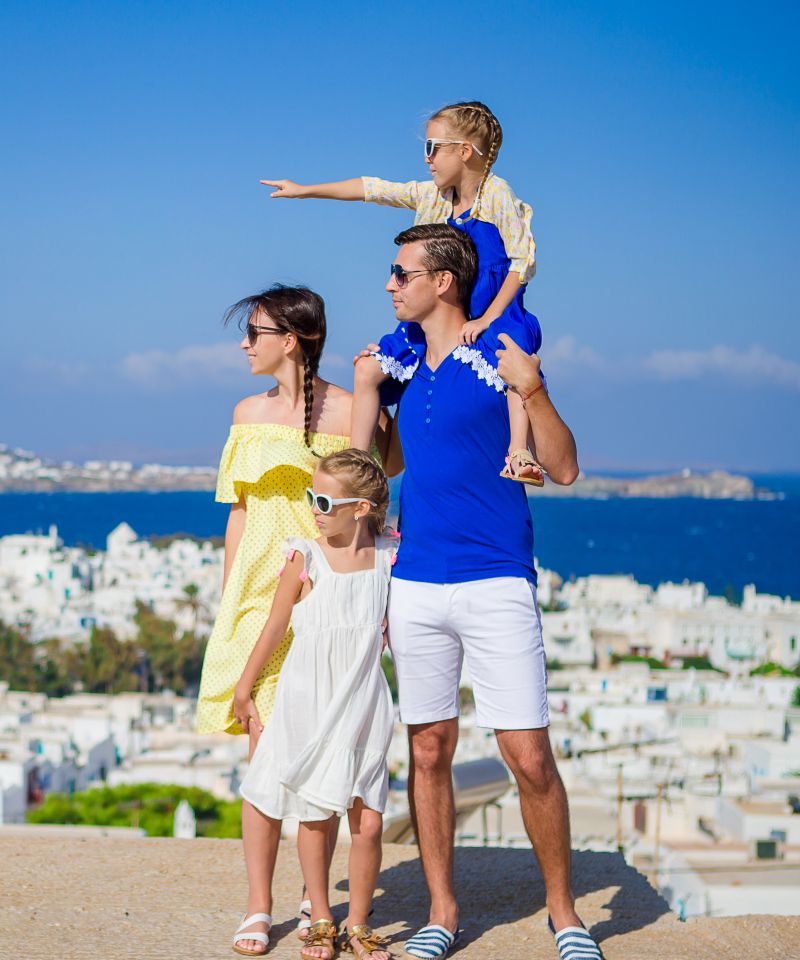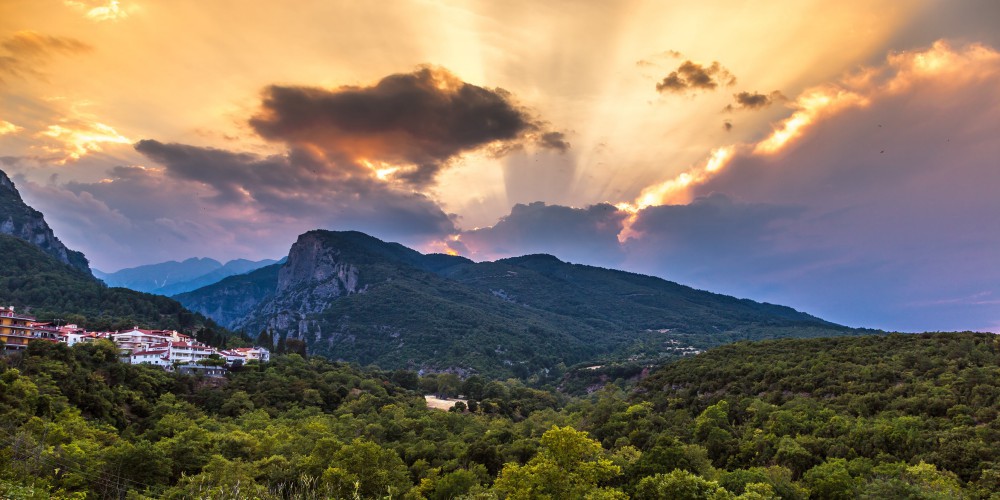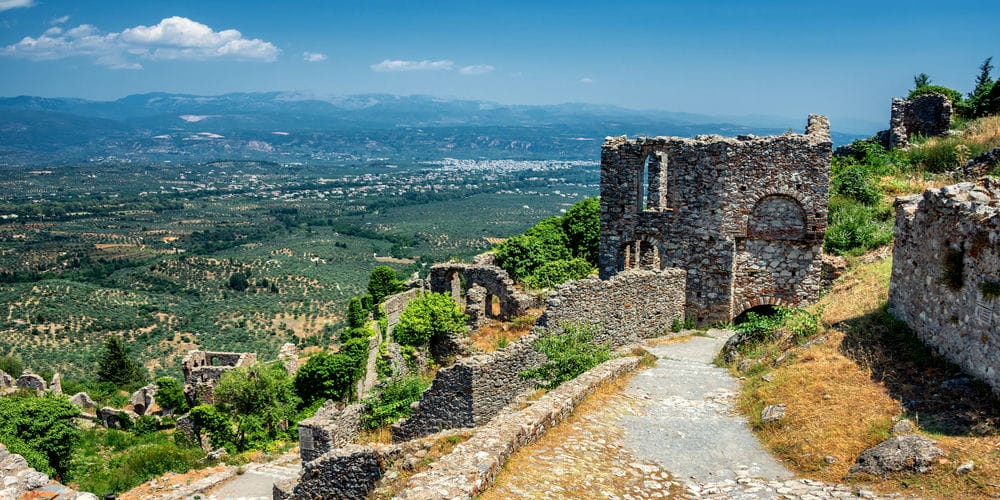
Mycenae, a Tale of Glory
Key Takeaways
- Mycenae was a thriving city during the Mycenaean civilization, which flourished from around the 16th to the 12th century BCE.
- The impressive Cyclopean walls were constructed using massive limestone blocks, creating a fortress-like appearance and showcasing the advanced engineering skills of the Mycenaeans.
- The Lion Gate is the main entrance to the citadel of Mycenae. It is adorned with two large lion relief sculptures and is considered an iconic symbol of the city.
- Excavations in Mycenae have unearthed a wealth of artifacts, including intricately designed gold jewelry, pottery, weapons, and religious objects, all of which one can admire in the Archaeological Museum of Mycenae.
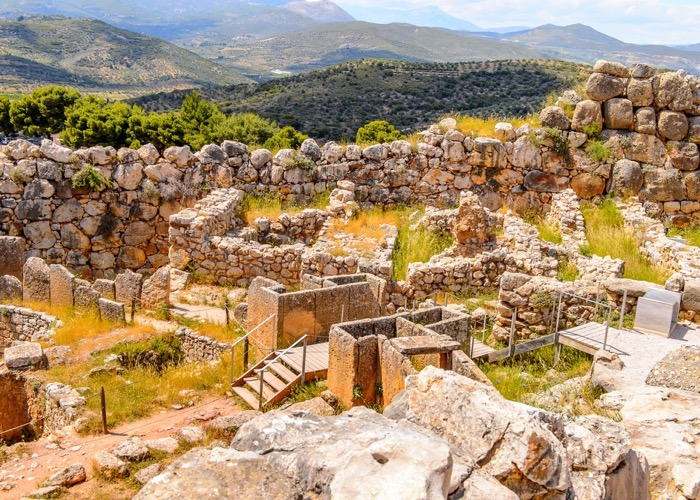 Mycenae - credits: Anton_Ivanov/Shutterstock.com
Mycenae - credits: Anton_Ivanov/Shutterstock.com
Mycenae, the ancient city that named a whole civilization after itself, lies in the low hillsides of Peloponnese close to the modern town of Argos in mainland Greece. Set on a trip traveling you back thousands of years and discover monuments so ancient that even ancient Greeks considered them ruins of antiquity.
Mycenae stretches across some kilometers northern to the city of Argos on the top of a low hill that overlooks the valley stretching until the shores of the Argolic Gulf.
Built on a naturally fortified location, the Acropolis of Mycenae is the first thing the visitor sees by the time he sets foot in the region.
Huge stone blocks were put in to create an impenetrable wall for the protection of the “Anax” and his people, Mycenae was for sure one of the most progressive and impressive places of prehistoric Greece.
Therefore, you should definitely not miss the chance to visit the birthplace of Agamemnon while in Greece and relive the history of Mycenae through the words of the most revered poet of them all, Homer.
Τhe history of Mycenae
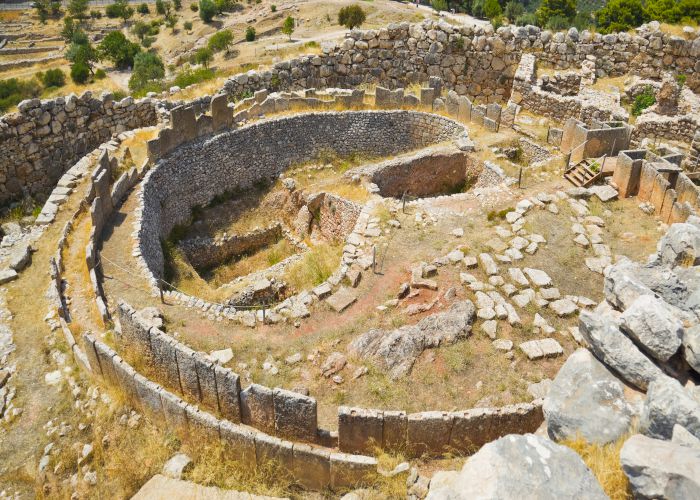 Tomb in Mycenae - credits: _PavleMarjanovic/Shutterstock.com
Tomb in Mycenae - credits: _PavleMarjanovic/Shutterstock.com
Although archaeologists have resulted in the fact that the location of Mycenae was inhabited since Neolithic times, the main settlement of Mycenae and the richest palatial centre developed after the coming of the first Hellenic tribes at the beginning of the second millennia BC.
The idea that even during that time period, a well-organized settlement with a distinct social hierarchy and significant production existed is proven by the discovery of much archaeological material and, more impressively, by the findings of the graves of approximately that period most likely belonging to the ruling class of Mycenae.
Even the very word 'Mycenae' has a questionable etymology. It is so old that scholars still debate its origins, although most of them agree on the fact that it should be pre-Hellenic and that it has to do with the location of the settlement.
During the next centuries, the population of Mycenae steadily increased, creating an urban center with an elaborate trading network, covering a wide geographical area and operating as a key role player in the politics of that time period.
In the 14th century BCE, the wealth of Mycenae was such that its acropolis was fortified with a wall built with colossal stone blocks. Even ancient people of the classical times, not being able to understand how their ancestors surpassed the technological difficulties of such endeavor, named these walls Cyclopean, believing that the mythical Cyclopes were responsible for their creation.
The famous Lion Gate
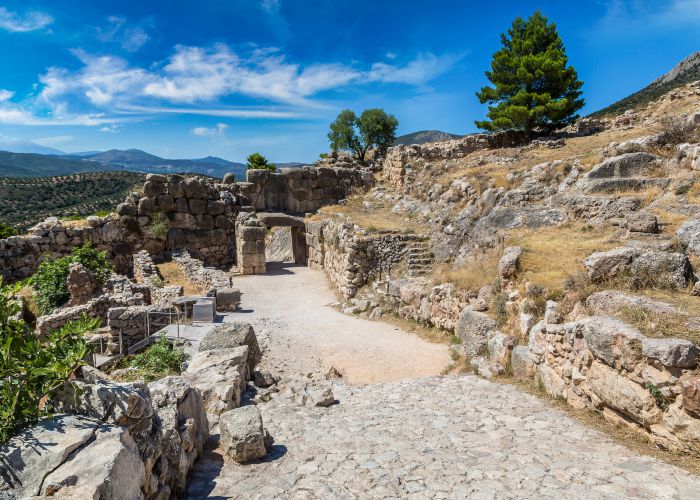 Mycenae, Lion Gate - credits: bloodua/Dpositphotos.com
Mycenae, Lion Gate - credits: bloodua/Dpositphotos.com
The walls of Mycenae expanded over the next century, and one of the entrances was decorated with a relief of two lions placed heraldically on an altar. This entrance is now known as the Lions Gate, an attraction of Mycenae since antiquity.
Except for its significance in Greek history, the relief of the lions in the Lion Gate in Mycenae is perhaps the earliest example of monumental sculpture to be found in mainland Europe as well.
Behind the massive walls of the Acropolis of Mycenae, people could find shelter and protection in times of need, and it was also the place where the ruling class of Mycenae used to live.
Right after the Lion Gate, today’s visitor passes by the ruins of Grave Circle A, a location of royal burials, some of them dated as far as 1600 BCE, and later Grave Circle B.
The Mycenaean civilization
 Mycenae - credits: Jane_Sta/Shutterstock.com
Mycenae - credits: Jane_Sta/Shutterstock.com
When the Cycladic and Minoan civilizations were at their peak, a new people, the Achaeans, came from the north and settled in central and southern Greece. These are the first Greeks.
The Achaeans got to know the Cycladic and Minoan civilizations and were impressed. They learned many things from the Cyclades and the Minoans and created their own culture, called the Mycenaean civilization.
It took its name from Mycenae, located in the Peloponnese, and was the largest center of this culture. Other Mycenaean centers were Thebes, Orchoienos, Athens, Iolkos, Pylos, Sparta, Tiryns.
The Mycenaeans or Achaeans, having as an example the Minoans, also became merchants. With their ships, they traveled all over the Mediterranean and reached Egypt, Palestine, and Cyprus.
They also occupied Crete, which, after the eruption of the volcano of Thera and the destruction of its cities, had lost its great power.
Later the Achaeans campaigned against Troy. The location of Troy was very important for trade. That is why the Achaeans wanted to conquer it and build their own trading post there.
The Trojan city, as we have learned, lasted ten years. The Achaeans conquered Troy, after which they slowly began to lose their power.
The German explorer Henry Schliemann was the first to make excavations and discover Mycenae, the Mycenaean citadel, and, therefore, the Mycenaean civilization, which is an integral part of the cultural heritage of Greece.
The development of Mycenae
The solid economic base of Mycenae was agriculture and animal husbandry.
At the same time, from a very early age, and with the palace as a regulating factor, various craft branches were developed. Stonework and metallurgy are some of the fields in which Mycenae was distinguished.
However, the greatness and radiance of Mycenae are mainly due to the development of shipping and trade. Especially from the middle of the 15th century BC, when the Mycenaeans occupied Knossos, the Greek Mycenaean element gradually dominated the sea and spread to the Mediterranean.
Such a maritime spread could not always be peaceful. The Trojan War echoed the overseas military operations of the time. The elements that united the various Greek races during the Mycenaean era were many. In general, it was the same as those that united the Greeks of historical times.
The first and strongest should be considered the common language - testified by the oldest Greek texts in Linear B - as well as the common religion and posthumous beliefs, as they can be detected through burial customs and practices. An additional cohesive element of Mycenae was the uniformity in the socio-political organization and the institutions.
As a natural result of the above ties and through the continuous transactions between the various Mycenaean centers, a single culture was created, the culture of the Mycenaean common.
Strictly hierarchical Mycenaean society resembles a pyramid, at the top of which was the anax. He, together with his family, lived in the palace, the center of power in each territory. The various courtiers and the priesthood followed in the hierarchy.
The inhabitants of each area were the municipalities. The municipalities were numerous and organized in villages around the administrative center and the palace. In addition to farmers and stockbreeders, the signs with text in Linear B provide us with an inexhaustible range of skilled craftsmen.
After taking over Crete in 1450 BC, Mycenae became a sea emperor. The Mycenaeans established colonies and trading posts throughout the Aegean and on the coasts of Asia Minor.
At the same time, in search of raw materials and markets, they traveled to the Near East, southern Italy, Sicily, and Spain and had sporadic contact with Central and Northern Europe.
They systematically colonized Cyprus and came in contact with the Hittite state. The Hittite records call the Mycenaeans Achiyava (Achaeans) and emphasize that their kingdom is a measurable naval power.
The fall of Mycenae and the Mycenaean civilization
In about 1200 BC. there was a sudden decline in Mycenaean power. Palaces, citadels, and settlements in Mycenae were destroyed. At the same time, Linear B disappeared.
We do not know exactly the reasons that caused this disaster. What actually happened in the Mycene remains unknown though theories abound.
According to some theories, Mycenae experienced many years of civil conflict and social upheaval. Dorians and Herclids invaded and sacked all Mycenaean cities except Athens. Raiders may have also impacted Mycenae. Mycenae may have been wiped out by disasters such as earthquakes, eruptions, or drought.
During the ancient Greek archaic period (7 to 5th centuries BC), an Athenian Temple was built on the summit of Mycena. Mycenae also served in the Persian Wars and sent 80 soldiers to Thermopylae. Argos, Mycenae's neighbor, remained silent during the conflict and retaliated and conquered the city, and destroyed some sections of its walls.
Other scholars attribute it to the movement of new Greek tribes, such as the descent of the Dorian, others to internal unrest, and others, finally, to the terrible unrest that prevails at this time in the eastern Mediterranean basin, with the fall of the Hittite state and the attacks of the so-called "peoples of the sea" against Egypt.
This upheaval resulted in the fall of the Mycenaean trade and the gradual decline of the Mycenaean palaces due to the economic crisis. In reality, the decline of Mycenae is due to a combination of all reasons listed above.
The Mycenaean civilization lost its power but did not collapse completely. Many elements of it survived and were transmitted to the next phase of Greek culture.
The Archaeological Site of Mycenae
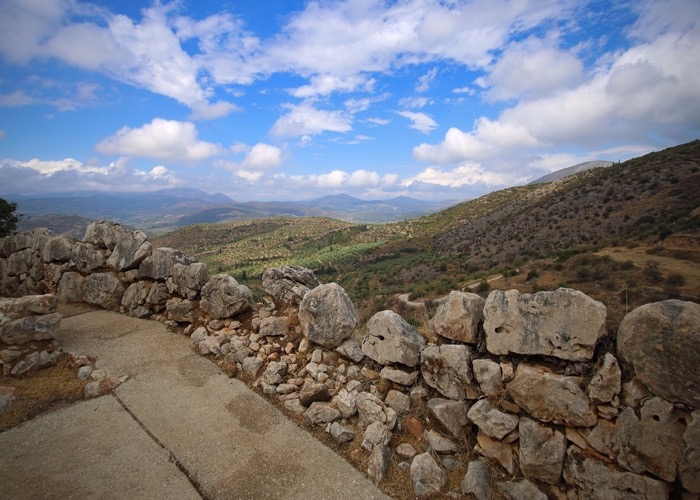 Mycenae - credits: Pavel_Kirichenko-shutterstock.com
Mycenae - credits: Pavel_Kirichenko-shutterstock.com
The archaeological sites of Mycenae and the Tyryns have been listed as UNESCO World Heritage Sites since 1999.
The famous archaeology enthusiast Heinrich Schliemann, after his excavations on the site of Troy, shifted his attention to Mycenae following the stories of Homer’s Iliad and the work of Pausanias. He arrived in the region and started excavating the area where he unearthed the peribolos and grave shafts of Grave Circle A.
Luckily, the tombs of Mycenae that date back to the Late Bronze Age had not been stripped from their offerings during antiquity; therefore, he was able to collect an unimaginable amount of treasures. As a result, he discovered one of the most well-preserved and important archaeological sites of classical Greek culture.
Some of them are the Golden Mask of Agamemnon, the Golden cup of Nestor, the Silver Siege Rhyton, and the plethora of jewelry, ornamented weapons, and personal items of exquisite craftsmanship using priceless materials.
Continuing up the grand road of the archaeological site after the Lion Gate, the visitor finds himself at the premises of the Mycenaean palace, located close to the highest point of the Acropolis. Known as the megaron, the palatial structure was the seat of the ruler with large halls decorated with vividly colored frescoes.
The very central point of the megaron was the throne room, where the ruler would sit on an elevated throne in front of a burning hearth. Most probably operating as the reception room, its decoration was there to impress foreigners and to provoke awe and respect in the subjects.
Some examples of the frescoes found at the megaron of Mycenae can be found at the National Archaeological Museum in Athens, which is the most important archaeological museum in the country, and where other significant pieces of the archaeological site are also preserved.

As luxurious as the lives of the ruling class might have been, it is certain that they also thought about their lives beyond death, something that became apparent from the funerary artifacts unearthed.
Huge megastructures were built to host the burials of more than one member of the royal family the individuals belonged to.
Known as tholos tombs, these structures were, and still are, a feat of engineering, and the site of Mycenae has nine of those examples, more than most archaeological sites. The most well-preserved and well-known tholos tombs, though, are the Treasury of Atreus and the Tholos of Clytemnestra.
The Treasury of Atreus, or the Tholos of Agamemnon as H. Schliemann named it, was built in ancient Greece around 1250 BCE. Despite its double name, scholars agree on the fact that probably another person was initially buried in the structure.
The monument was described by Pausanias, the traveler of the 2nd century AD, and its location was known throughout the centuries. The Mycenaeans used a technique called corbelling in order to create a huge space with no additional support to its dome, holding up massive amounts of dirt since it is buried as a tumulus.
The Treasury of Atreus has a diameter of about 14.5 meters, and it used to be the largest space covered with a dome until the creation of the temple of Hermes in Baiae and the Pantheon in Rome!
Its lavish decoration and sculptural ornamentation have survived in a fragmentary state, but they surely give us an idea of the splendor and scale of the building.
Another Grave Circle located outside of the walls of Mycenae and its Lion Gate provided the archaeologists with more information about this long-gone civilization and filled the gaps that the research conducted by H. Schliemann left in the history of Mycenae.
More archaeological sites of Mycenae and lavish buildings with spectacular frescoes, shrines, temples, and a big residential area are some of the things you are going to witness during your trip to the birthplace of Agamemnon. People continued to live at the glorious ruins of Mycenae until Hellenistic times.
In classical times, the accounts inform us that the Mycenaeans contributed to the Persian Wars by participating in the battles of Thermopylae and Plataea.
Although this new town was much smaller in scale, it had many public buildings incorporated into the much older, still operating shrines of the past. A temple at the Acropolis of Mycenae was built as well.
Mycenae in Greek Mythology
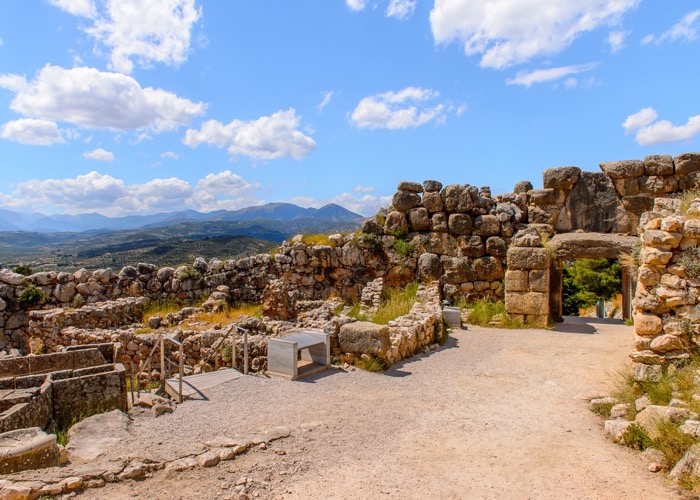 Mycenae - credits: Anton_Ivanov/Shutterstock.com
Mycenae - credits: Anton_Ivanov/Shutterstock.com
According to Greek Mythology, the founder of the Mycenaean kingdom was the hero Perseus. When his last descendant, King Eurystheus, the one who defined the deeds of Hercules, lost his life, the people voted for a new king, Atreus.
Atreus's brother, Thyestes, seduced his wife to usurp the throne, and the king took revenge on Thyestes by killing his two sons and serving them to him. Thyestes then cursed Atreas and his house never to find prosperity.
The successors of the house of Atreus were Agamemnon and Menelaus. Agamemnon inherited the kingdom of Mycenae, and Menelaus became the king of Sparta. The two brothers married two sisters, Clytemnestra and Eleni, respectively.
Legend has it that the three goddesses Hera, Athena, and Aphrodite competed to see who was the most beautiful, with the winner being the prince of Troy, Paris. Each tried to bribe him to be chosen by the prince.
Aphrodite promised him if he won, the most beautiful woman in Greece, who was the beautiful Eleni -the wife of Menelaus-. With the help of the goddess, the beautiful Eleni followed Paris to Troy, thus making Menelaus, in revenge, declare war on the Trojans.
Thus began the famous Trojan campaign. Menelaus, with the help of his brother Agamemnon and the Greek kings, marched to Troy.
On the occasion, when the throne was empty, Aegisthus, the son of Thyestes, found the opportunity and approached Agamemnon's wife, Clytemnestra. With her help, he took power and reigned with her for ten years, and they had three children.
As soon as he returned, Agamemnon from Troy, Clytemnestra, and Aegisthus were killed. Orestes, son of Agamemnon, wanting to avenge the unjust death of his father, killed his mother and her lover and seized power.
Orestes then married Hermione, daughter of Menelaus and Helen, and so the kingdoms of Mycenae and Sparta were united.
After some time, the descendants of Hercules, called Heraclides, came and overthrew the king, and thus, the cycle of the Atreides ended in misery.
Final Thoughts
Mycenae is for sure a place of wonder, and its Acropolis still captivates the imagination of the people reflecting on stories of war and glory.
Put Mycenae, this UNESCO World Heritage Site, on your bucket list, plan your own visit there, or check out one of our Greece tours, and soon you'll be passing through the Lion Gate into a world of wonder!
Frequently Asked Questions
How was Mycenae destroyed?
Was Mycenae the first Greek state?
What is Mycenae known for apart from its archaeological sites?






